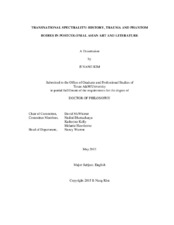| dc.description.abstract | This dissertation proposes “transnational spectrality” as a socio-cultural phenomenon of a globalized world. Examining ghosts as metaphors of subaltern or counter-hegemonic transnational subjectivity, memory and history, this study focuses on transnationalism’s potential by exploring the intersection between terms, such as the subaltern, spectrality, transnational Asia, colonial/postcolonial histories, trauma and bodies. Particularly discussing postcolonial Asian literature and art works that dramatize traumatic historical events in Korea, India, and Sri Lanka, this project investigates how these cultural products construct a spectral vision of nations and the world through their metaphoric uses of wounded or phantom bodies.
This dissertation begins with the examinations of Nora Okja Keller’s Comfort Woman (1997) and the Korean-American female artists’ works—Yong Soon Min’s decolonization (1991) and Remembering Jungshindae (1992), Soo Jin Kim’s “Comfort Me” (1993) and Miran Kim’s Comfort Women (1995-8) that explore the history of comfort women—sexual slaves for Japanese imperial armies during World War II. By representing traumatized female bodies as emblems of the inherited trauma of the homeland, these diasporic producers provide an alternative paradigm for transnational history that challenges not only Japanese and American masculinist colonialism/neocolonialism, but also Korean patriarchy and nationalism. This project also examines how Salman Rushdie, whose novel Midnight’s Children (1981), and Indian-origin artists such as Sutapa Biswas, Yatin Patel, Surekha and Reena Saini present visions of “spectral India”—the nation as a liminal/hybrid space—through their manifestations of houses and bodies haunted by historical trauma. This project extends its investigation to Michael Ondaatje’s Anil’s Ghost (2000) along with Sri Lankan local and global artists—Bandu Manamperi, Janani Cooray, Pradeep Chandrasiri, R. Veidehi and Kali Arulpragasam. These Sri Lanka cultural producers portray the spectralized victims of the Sri Lankan Civil War as metonyms of the national trauma, presenting the wounded or phantom body as a communicative space that links personal trauma to collective trauma on a local, national and global scale.
Finally, Transnational Spectrality concludes that these postcolonial Asian practitioners emerge as transnational agents who can offer a fuller understanding of Asia to the transnational world by representing the fear, pain and suffering that Asian communities bear as the consequences of colonialism and its aftermath of violence. | en |


